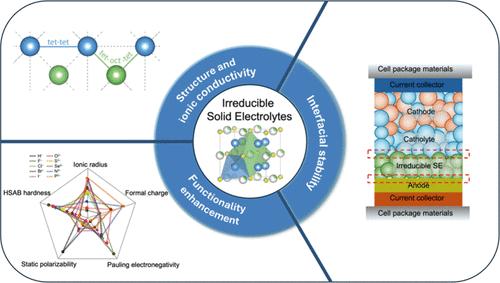Irreducible Solid Electrolytes: New Perspectives on Stabilizing High-Capacity Anodes in Solid-State Batteries
IF 18.2
1区 材料科学
Q1 CHEMISTRY, PHYSICAL
引用次数: 0
Abstract
Irreducible solid electrolytes (SEs), characterized by non-Li framework ions in their lowest oxidation states, offer intrinsic compatibility with low-reduction-potential, high-capacity negative electrodes, such as lithium metal and silicon. In these SE materials, disorder engineering and vacancy formation reduce lithium-ion diffusion barriers, achieving room-temperature ionic conductivities exceeding 0.1 mS cm–1. Experiments and atomistic simulations confirm that irreducible SEs form decomposition-free interfaces with Li metal. Their limited oxidative stability can be addressed by pairing them with an electrolyte layer stable with practical cathodes yet demanding interface compatibility between the two electrolyte layers. Here we highlight key research directions to accelerate irreducible SE transition from laboratory to practical application, including expanding compositional diversity, optimizing interfaces with cathode-facing electrolytes, developing scalable thin-film processing, and exploring compatibility with other low working potential anodes like silicon. Addressing these challenges is essential to unlock the full potential of irreducible SEs for high-energy, long-life, all-solid-state batteries.

不可还原固体电解质:稳定固态电池大容量阳极的新视角
不可还原固体电解质(SEs)的特征是处于最低氧化态的非li框架离子,具有与低还原电位、高容量负极(如锂金属和硅)的内在兼容性。在这些SE材料中,无序工程和空位形成降低了锂离子扩散障碍,实现了超过0.1 mS cm-1的室温离子电导率。实验和原子模拟证实,不可还原的se与Li金属形成无分解界面。它们有限的氧化稳定性可以通过将它们与具有实际阴极的稳定电解质层配对来解决,但要求两个电解质层之间的界面兼容性。在这里,我们强调了加速从实验室到实际应用的不可还原SE转变的关键研究方向,包括扩大成分多样性,优化与阴极电解质的界面,开发可扩展的薄膜工艺,以及探索与其他低工作电位阳极(如硅)的兼容性。解决这些挑战对于释放不可还原se的全部潜力,实现高能量、长寿命、全固态电池至关重要。
本文章由计算机程序翻译,如有差异,请以英文原文为准。
求助全文
约1分钟内获得全文
求助全文
来源期刊

ACS Energy Letters
Energy-Renewable Energy, Sustainability and the Environment
CiteScore
31.20
自引率
5.00%
发文量
469
审稿时长
1 months
期刊介绍:
ACS Energy Letters is a monthly journal that publishes papers reporting new scientific advances in energy research. The journal focuses on topics that are of interest to scientists working in the fundamental and applied sciences. Rapid publication is a central criterion for acceptance, and the journal is known for its quick publication times, with an average of 4-6 weeks from submission to web publication in As Soon As Publishable format.
ACS Energy Letters is ranked as the number one journal in the Web of Science Electrochemistry category. It also ranks within the top 10 journals for Physical Chemistry, Energy & Fuels, and Nanoscience & Nanotechnology.
The journal offers several types of articles, including Letters, Energy Express, Perspectives, Reviews, Editorials, Viewpoints and Energy Focus. Additionally, authors have the option to submit videos that summarize or support the information presented in a Perspective or Review article, which can be highlighted on the journal's website. ACS Energy Letters is abstracted and indexed in Chemical Abstracts Service/SciFinder, EBSCO-summon, PubMed, Web of Science, Scopus and Portico.
 求助内容:
求助内容: 应助结果提醒方式:
应助结果提醒方式:


